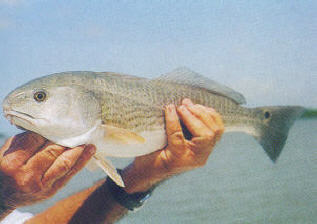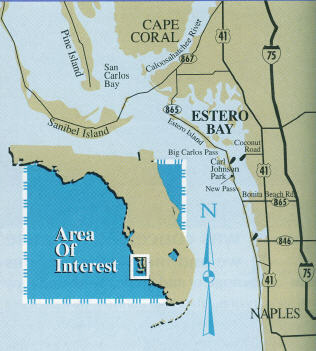May 16, 2011
By Jim Demarest
Scout the flats of Estero Bay for all-season redfishing in Southwest Florida.
By Jim Demarest
 That trademark overbite points to a diet of crabs, shrimp and other bottom critters. |
By now the sun was up, and what had been featureless silhouettes were lit in burnt orange and tipped with electric blue. Redfish were everywhere, waving their tails in the air as they fed. It was a beautiful sight, and it was evidence that the spot-tailed residents of Estero Bay, in Southwest Florida, were invigorated by the changing season. But, the tide was near dead low and the fish looked alert, so I knew we would have to use every advantage built into my 16-foot flats skiff.
We approached a pair of fish cautiously. I was on the poling platform; up front, good friend Robin Doyle and Emily, his 18-year-old daughter, were ready to go with live greenbacks and 8-pound spinning outfits. At the right moment, they cast in the path of the tailers, well out front so as not to alarm the fish.
Advertisement
No bites.
We were dumbfounded. The reds had already ignored a gold spoon and soft-plastic shrimp, both great lures at this time of year. We'd used some valuable fishing time cast netting the greenbacks under some diving birds.
Advertisement
“Okay, time to quit the finesse stuff,” I announced. “When his tail is in the air, hit 'em on the head.”
Robin was the first to land his bait on the mark and was quickly rewarded by a long, hard run. We boated the 24-incher and got back to business. With Emily up front we approached another tailing trio. Taking a page out of her father's book, she too hooked and landed a 2-foot red. With tails still waving across the flat, Robin couldn't resist, and grabbed his fly rod.
“What do you think?” he asked.
“I'd go with a shrimp pattern,” I said.
Moments later, Robin was putting the fly on fish. He must have hit over a dozen on the head before finding a taker.
“Hit him Robin, hit him,” I urged as the line drew taut. And with a splash the first run started.
“Emily, get ready to cast,” I ordered, as I poled us ahead to another tailing fish. Within range, the greenie hit the mark. In a pop and swirl, and powerful flips of a spotted tail, she was hooked up, too.
Anglers circled the boat in a redfish dance, each working the fish closer. At one point, father and daughter stood back to back on the bow, each with rod doubled over. Five minutes after Robin's hookup both fish were in the boat. We quickly measured each at 25 inches, and paused to snap a photo of Robin's first redfish on a fly. We slipped the fish back into the water and returned to the ramp.
We had experienced Estero Bay redfishing at its finest, and agreed that there was no way we were going to do any better. Besides, it was time for lunch, and our opportunity to retell old Estero Bay stories and plan for ones yet to come.
Estero Bay is a 7-mile-long shallow water playground between Naples and Fort Myers that provides a variety of fishing environments for the backwater enthusiast. Flats, mangrove shorelines, oyster bars and channels offer productive fishing for redfish and other species at all tides year-round. And while located off the beaten path, it is not a hard place to get to.
Summer's end is one of the best times to visit the bay, when the water is cooling and the reds are feeding in anticipation of winter. Fish begin to school, sometimes in large numbers, and push big wakes ahead of them. Live bait, artificial lures and flies all take fish. My favorite way of catching them is to sight fish for tailers along the flats of the eastern shore. Such was our plan when Robin, Emily and I launched the skiff at sunrise at Weeks Fish Camp.
Located at the end of Coconut Road, west off US 41 about five miles north of Bonita Springs, Weeks Fish Camp has been around for ages. The facilities are small and rustic, but the bait is good and the people are always willing to talk fishing, which more than makes up for the lack of polish. Departure from Weeks or nearby Carl E. Johnson Park, midway between Bonita Springs and Fort Myers Beach, puts you into a marked channel for immediate access to Estero Bay, but before racing away from the ramp, a word of caution: Navigating Estero Bay without mishap requires experience, especially at low tide. Being 200 yards from shore does not guarantee safe passage as large flats extend beyond this limit, as do lower unit-eating oyster bars and mounds.
 Although convenient to roads, Estero Bay is virtually surrounded by a buffer of mangroves. |
Take time during your first few trips to Estero to learn the waters before charging around the bay on plane, even in the shallowest-draft boat. Bring a pushpole if you own one, and pay attention to the tides. The safest bet is to navigate the bay via the marked channels, then idle, drift, or pole to your fishing spots. The bay is small enough that you won't get an Olympic workout pushing yourself around, and the scenery is great.
While there are definite signs of development around Estero, the bay remains much the same as it looked hundreds of years ago when the Calusa Indians called the area home. Large groups of mangrove islands in the northern part of the bay can be fished all day without seeing another boat. The variety of habitat found throughout Estero Bay means good fishing for sheepshead, trout, snook and redfish. In fact, the Bay provides a year-round home for redfish, although their behavior changes with the seasons.
Estero Bay redfish are heavily influenced by tide and water temperature. To catch reds all year, anglers must vary their approach based upon the prevailing conditions. As a result, each season brings with it a different approach to redfishing to take advantage of the opportunities nature provides.
After fattening up during the fall, Estero Bay redfish slow down in the wintertime and can be a tremendous challenge to take on artificials. The cool water and ever-passing cold fronts make live bait a must for consistent success. Fortunately, winter shrimp are large, plentiful, and a redfish favorite. While a popping cork or tipped jig are producers, the cool weather often leads to clear water sightfishing opportunities. Try the flats along the eastern shore south of Coconut Point. With just a shrimp on a hook I l
ook for fish on the latter part of the falling tide or the first part of the incoming, searching the flats where warmer water beckons the fish. Cooler water slows the bite some, but the payoff is more energetic fish that thrash and fight hard all the way to the boat, only to run again at the first sight of the hull.
Springtime brings warmer water and light winds to Estero Bay, which makes for great artificial lure conditions. While a gold spoon remains a reliable producer, redfish will slam darker jig patterns and many small minnow lures. The key is to work mangrove shorelines north of Coconut Point on the eastern shoreline at high water, and the oyster mounds a mile south of Coconut Point located 150 yards from shore around the lows. Flats fishing with artificials is hit and miss, with jigs being your best bet. Fly fishing becomes more practical so long as the winds stay low, with shrimp and crab patterns favored.
Summer in Estero Bay is mangrove time, with the best fishing reserved for the higher half of the tide along the entire eastern shore of the Bay. Live bait is plentiful for cast netters, and shrimp, though small, can be found at most marinas. Whatever live bait is available, I prefer to hang it under a 2-inch weighted popping cork. The weight gives me a more consistent feel, which helps with the pinpoint accuracy required along the mangroves. Mangrove fishing in Estero Bay is not for the timid angler, as you must get the bait close to (read underneath) the mangroves to take advantage of the cooler conditions provided by the shade. “If you don't end up in the trees once in a while, you're not getting close enough” is the phrase that pays, and experienced anglers can often flip their stranded shrimp and cork out of the mangroves without having to pole all the way to the shoreline in face of the inevitable comments from fellow boat-mates. But the ribbing doesn't usually go too far because the next time...well, you know how the story goes.
FS
